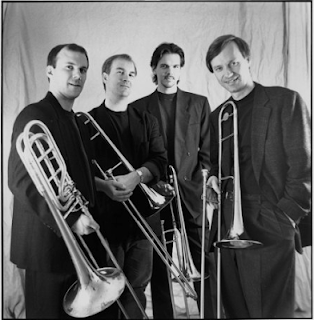I found this wonderful article by Pete McGuinness in my 2007 JAZZed Magazine. I found it very relevant for today. Let me know what you think. Oh, you might want to read more information about him at, www.petemcguinness.com
Some of the greatest experiences an arranger can have are the opportunities to lovingly "mess with" someone else's melody. It is also the one aspect of arranging which I've found that less experienced musicians are the most intimidated by. However, altering aspects of a song's melody shouldn't be looked upon as something that is taboo. Rather, the process can be thought of as actually paying tribute to what makes a work great in the first place.
Selection and Approach
When picking a melody I want to reformat, I always try to select a tune I feel a strong personal connection with. But even when working with lesser material, it is important to find something to love about the given tune and to deeply understand the song's structure and history. This will keep you inspired and informed, helping creative ideas come more easily.
If the selected tune is one the average listener is generally familiar with, then the way an arranger treats it can act as a window into his or her creative thinking and personal style. Whenever possible, it helps to start by listening to a recording of the original version of the song, or at least a version done in the traditional manner. This will help make clear the tune's original intention as a composition. Assuming there exists plenty of freedom to alter various aspects of the song (melody, harmony, style, meter, etc.), the most crucial choice the arranger first makes is with respect to the new overall "feel" of the composition. This decision should be allowed to evolve very generally, by choosing basic things like tempo, overall level of tension, and so on.
Then, the arranger should pick a rhythmic style that best addresses those overall ideas. For example, if I want to turn a standard-sounding ballad into something "fast" and more "tense" in mood, I might select a samba for the groove, with a heavily syncopated treatment of the melody, perhaps adding some unusual re-harmonizations as well. Maybe
I would also incorporate some kind of underlying rhythmic vamp figure, which could possibly enhance the feeling of tension. Not every change of groove or tempo is going to work for the arranger, personally. He or she must sit with the tune for a while and play around until something feels right. It's really a matter of taste.
The idea here is to convince the listener that your new arrangement of the tune could, in fact, be the originally intended version - very tricky to pull off! But, if the arranger is familiar enough with the rhythmic and stylistic language of many styles of music (underlying drum patterns, bass lines/comping patterns, traditional rhythmic treatment of melodies), he or she will have more options, and the music will sound authentic. Personally, I find this to be one of the most fun parts of the arranging process.
I suggest trying lots of approaches out. You may find that you can hear the tune in more than one new context, so you should give yourself time to find the "right" one. Most importantly, pick one in which you can hear the melody work within the rhythmic style. Remember, it is generally the melody that is the most important aspect of any song, so deal with it first. You can worry about re-harmonization, orchestration, and everything else later. They are the icing on the cake in comparison (the exception being a more conservative alteration of the melody in favor of other changes, such as more heavy reharmonization, vamps, etc.) Regardless of the style chosen, let it be one that is familiar to you. I often start by listening to classic recordings, typical of the genre I've chosen for my chart, in order to get my head into the specifics of the style. Then, I'll think about the structure of the melody I'm arranging in relation to this chosen groove.
In some situations, this may seem like putting a square peg into a round hole, but if you think about the original rhythmic design of the tune's pitches, and compare that to traditional melodies in the chosen style, you may see rhythmic possibilities leap out at you. Trust your ear and your knowledge of the style. Remember, there is some reason you first chose this approach for the tune (or more likely, it chose you). Start by experimenting with the layout of the pitches. If the song has lyrics, even if the arrangement is to be an instrumental, try to hear the lyrics of the song as you restructure the pitches. Do the words still seem to have a grammatical flow and logic? Melodic structures working with lyrics are often composed with this in mind. How about rhythmic sequences in the original's phrases? Where's the tune's climax (usually the highest note somewhere towards the end)? The arranger must thoroughly understand the important features of the tune's original melodic structure, and use technique to "comment" on them.
Interpreting a Smile
If you look at the notation examples, I've prepared, you'll see various re-working of a song near and dear to my heart, "Smile," by
Charlie Chaplin for the soundtrack to his film
Modern Times (1936)...
In the examples below, I've tried to come up with several possible contexts in which "Smile" might appear, while trying to retain as much of the tunes original character as possible. Example 1 is simply the straightforward, unaltered presentation of the song's first four bars (for reference). Notice that the first note is a longer time value (half note) than the notes that follow.
Arranging : Rhythmic Context Change
Ex.1) Original, unaltered version (first four vars)
4/4
C D E / D C
B A / B C D / C B A G
If you clearly establish what the tune is early on, you will have more liberty to stray further from the tune later on... Notice the various grooves and styles that have been chosen, and how the melody has been made to fit
rhythmically. In examples 2-6, only the original pitches were used, nothing extra.
Ex. 2) With
common swing-type phrasing (various
tempi)
4/4 rest C D E D / tie C B A B / tie C D C / tie B A G
Ex. 3) As a
bossa-nova
4/4 rest C tie D E D / tie C B tie A / rest rest B tie C D C / tied b A tied G
Ex. 4) As a
samba
2/4 rest C D E D / rest C rest B rest A B / tie C tie D C / tie B A G A
Ex. 5) As a
jazz waltz
3/4 rest C rest D E / D C B A / B rest C D / C B A G A
Ex. 6)
Light swing - playing around drum brushwork (i.e. "
Soft Shoe")
4/4 C rest rest D E D / rest rest C B A / rest B C D C / rest rest B rest A G
Ex. 7) With
embellishments around melody's original pitches
4/4 C rest D E D B E D / rest G C D C B C A tied / rest rest B C D C / rest G D E B A B G tied
In Closing
... The key is to have enough of both reused and varied material to keep things interesting. This is part of the game of arranging - the fun of pulling the listener along, giving them something to guide their ears through the chart, such as reuse of material, as well as offering surprises along the way. Good luck. I hope you will feel more confident that it is okay to "mess with" other people's music, even famous tunes. If your arrangement is done well, you may find that the composer will be very flattered!
Great article, thank you!
You may be interested in Backpocket Band Software
Back Pocket Band is a unique best metronome like product that is much
more than a traditional metronome. Back Pocket Band provides a
track-like experience including a drum beat, base, or cool slamming grooves!
Here's one example,
http://www.youtube.com/watch?v=xfoCBgQLcXk
All the best,

"The beautiful thing about learning is that no one can take it away from you."
B.B.King























![Validate my Atom 1.0 feed [Valid Atom 1.0]](valid-atom.png)







